Key Takeaways
- Implementing a buddy system can improve employee retention, job satisfaction, and productivity in the workplace.
- Clear guidelines for the buddy system are crucial for its success, including defining goals, establishing roles and responsibilities, and encouraging communication.
- Ongoing training and evaluation are necessary for maintaining an effective and sustainable buddy system.
Are you tired of feeling like a lone wolf in the workplace?
Do you crave the camaraderie and support of a fellow employee, but aren’t sure how to make it happen?
Fear not, my friend.
The buddy system is here to save the day (and your sanity)!
Now, before you start imagining yourself hand-in-hand skipping through the office like a scene out of a cheesy 80s movie, let’s get serious for a moment.
The buddy system is a proven method for improving workplace relationships, increasing productivity, and enhancing employee satisfaction.

And who doesn’t want all of those things?
But wait, there’s more.
According to Aberdeen, 54% of organizations with a formal onboarding process experience greater new hire productivity, and 50% experience greater new hire retention.
Glassdoor reports effective employee onboarding increases retention by 82%.
Not only does the buddy system provide invaluable emotional support and a sounding board for ideas, but it also promotes accountability and helps you stay on track with your goals.
It’s like having a personal cheerleader, therapist, and coach all rolled into one (minus the outrageous fees).
Now, I know what you’re thinking. “But how do I create a buddy system?
Is it like choosing a partner in gym class all over again?”
Not quite.
The process is actually quite simple and straightforward.
All it takes is a little bit of planning, communication, and some solid guidelines to get you started.
So, whether you’re a seasoned veteran in the workplace or a fresh-faced newbie, the buddy system is a game-changer that you won’t want to miss out on.
Get ready to make a new friend, boost your productivity, and take your career to the next level with this comprehensive guide to creating a buddy system in the workplace.
Buckle up, buttercup, because we’re about to embark on a journey of epic proportions.
Before we venture further into this article, we like to share who we are and what we do.
About 9cv9
9cv9 is a business tech startup based in Singapore with a strong presence worldwide.
With over six years of startup and business experience, and being highly involved in connecting with thousands of companies and startups, the 9cv9 team has listed some important learning points in this overview of how to create the best “Buddy System” in your company.
If your company needs HR and Recruitment services, you can use 9cv9 headhunting and recruitment and EOR services to hire top tech talents and candidates worldwide. Book a consultation slot here, or send over an email to [email protected].
Buddy System: A Comprehensive Guide to Create One in the Workplace
- How to Create a Buddy System in the Workplace
- Best Practices for Successful Buddy System Implementation
- Challenges and Solutions
1. How to Create a Buddy System in the Workplace
Now that you’re convinced that a buddy system is the way to go, let’s dive into how to create one in the workplace.
A) Identify the Purpose of the Buddy System
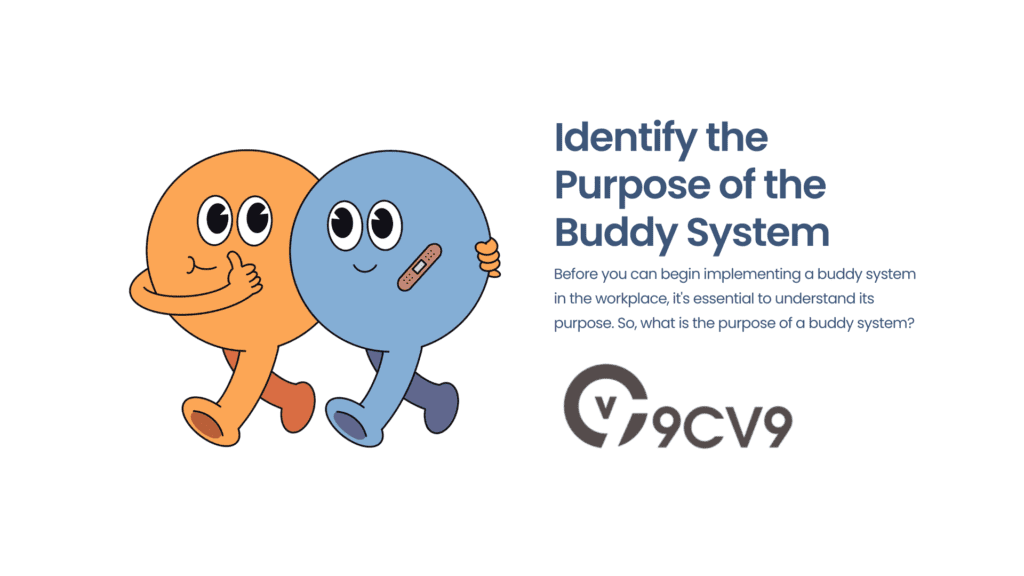
First things first, you need to identify the purpose of the buddy system.
Are you looking to foster better communication between departments?
Are you hoping to provide a support system for new hires?
Do you want to promote collaboration on projects?
Before you can begin implementing a buddy system in the workplace, it’s essential to understand its purpose. So, what is the purpose of a buddy system? Let’s explore.
Purpose #1: Onboarding and Training One of the primary purposes of the buddy system is to help new hires feel welcomed and supported during the onboarding process. A buddy can provide guidance and support, answer questions, and help new employees navigate the company culture and expectations. Additionally, a buddy can assist with training and development, helping the new hire to learn the ropes and get up to speed faster.
Purpose #2: Skill Development and Knowledge Transfer Another purpose of the buddy system is to facilitate skill development and knowledge transfer. Buddies can share their expertise and experience with each other, providing opportunities for growth and learning. For example, a seasoned employee can teach a new hire how to use a specific software program or share best practices for handling difficult customers.
Purpose #3: Accountability and Support The buddy system can also be used as a tool for accountability and support. Buddies can set goals together and hold each other accountable for meeting those goals. Additionally, buddies can provide emotional support during challenging times, such as when dealing with a difficult project or personal issue.
Purpose #4: Engagement and Retention Finally, the buddy system can help improve employee engagement and retention. When employees feel supported and connected to their colleagues, they are more likely to stay with the company long-term. Additionally, the buddy system can provide opportunities for employees to build relationships and feel like they are part of a team, leading to increased job satisfaction.
In summary, the purpose of the buddy system is multi-faceted. It can be used for onboarding and training, skill development and knowledge transfer, accountability and support, and engagement and retention. By understanding the purpose of the buddy system, you can ensure that it is implemented effectively and that it provides maximum benefit to all involved.
B) Selecting Buddies
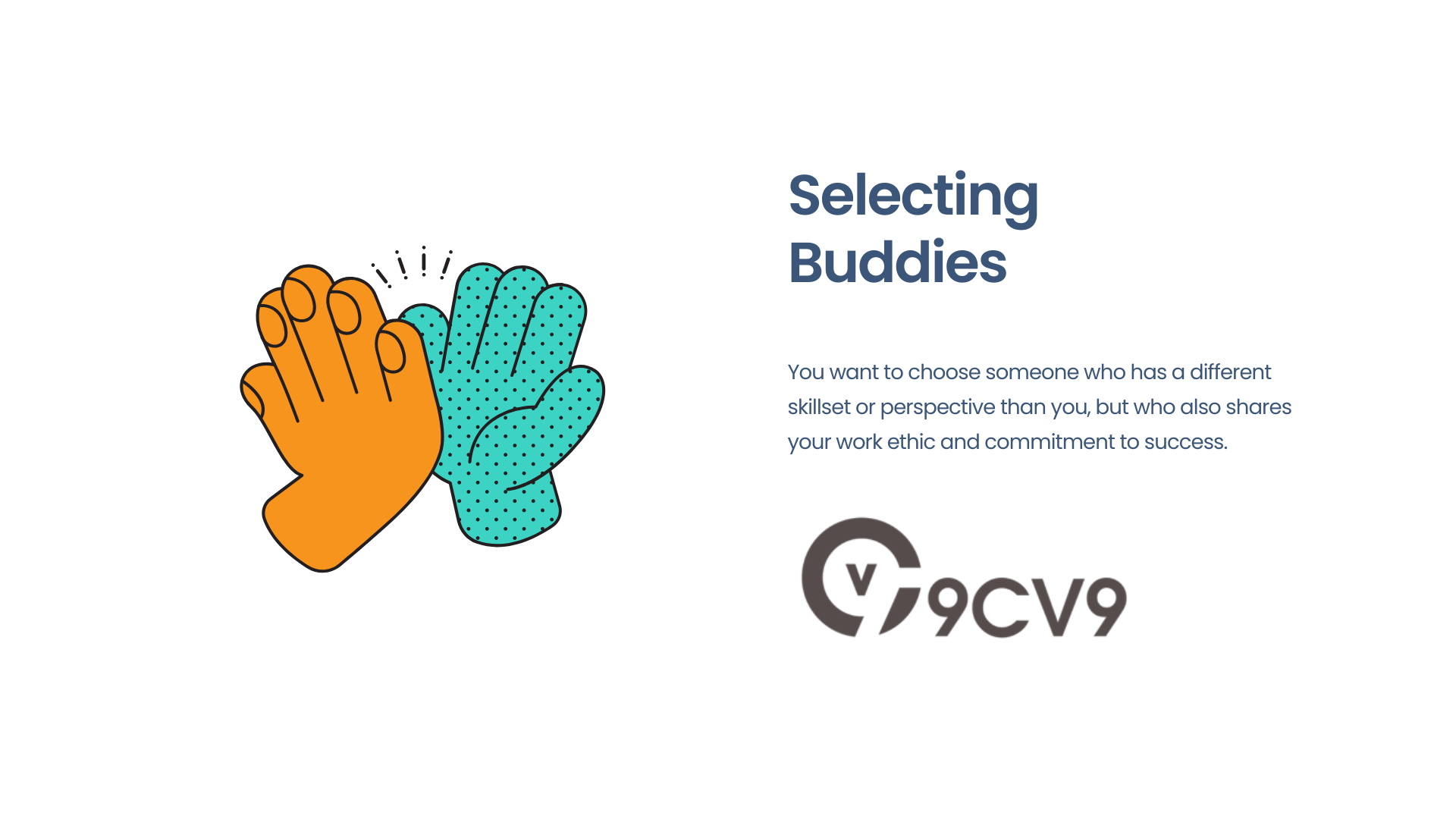
Next, you’ll want to choose your buddies.
This is not the time to simply pick your office bestie or someone who will always agree with you.
You want to choose someone who has a different skillset or perspective than you, but who also shares your work ethic and commitment to success.
Think of it as a matchmaker for your career.
Swipe left on the slacker who takes three-hour lunches, and swipe right on the go-getter who always meets deadlines.
Choosing the right buddy is essential to the success of the buddy system in the workplace.
But how do you go about selecting buddies?
Here are some tips to help you choose the best match.
Tip #1: Consider Compatibility: When selecting buddies, it’s important to consider compatibility. Buddies should have similar goals, interests, and work styles to ensure a productive and enjoyable partnership. For example, if one employee is highly structured and organized, they may not be the best match for someone who is more spontaneous and creative.
Tip #2: Look for Complementary Skills: Another factor to consider when selecting buddies is complementary skills. Buddies with different areas of expertise can learn from each other and fill in each other’s knowledge gaps. For example, an employee with strong communication skills can be paired with someone who is skilled in data analysis to create a well-rounded partnership.
Tip #3: Seek Diversity: It’s important to seek diversity when selecting buddies. Diversity can bring fresh perspectives and ideas to the table and help break down barriers. For example, pairing up an employee from a different department or with a different cultural background can provide unique insights and help broaden everyone’s horizons.
Tip #4: Consider Personalities: Personalities are an essential factor when selecting buddies. Buddies should have compatible personalities to ensure a positive and productive working relationship. For example, if one employee is introverted and prefers to work independently, they may not be the best match for someone who is extroverted and thrives in a collaborative environment.
Tip #5: Allow for Choice: Finally, it’s important to allow employees to choose their own buddies whenever possible. When employees have a say in the selection process, they are more likely to feel invested in the partnership and motivated to make it work. However, if necessary, managers can step in to facilitate the selection process and ensure that each buddy pairing is a good match.
In summary, selecting buddies requires careful consideration of compatibility, complementary skills, diversity, personalities, and employee choice.
By taking the time to choose the right buddies, you can ensure that the buddy system is effective and provides maximum benefit to all involved.
C) Training and Orientation
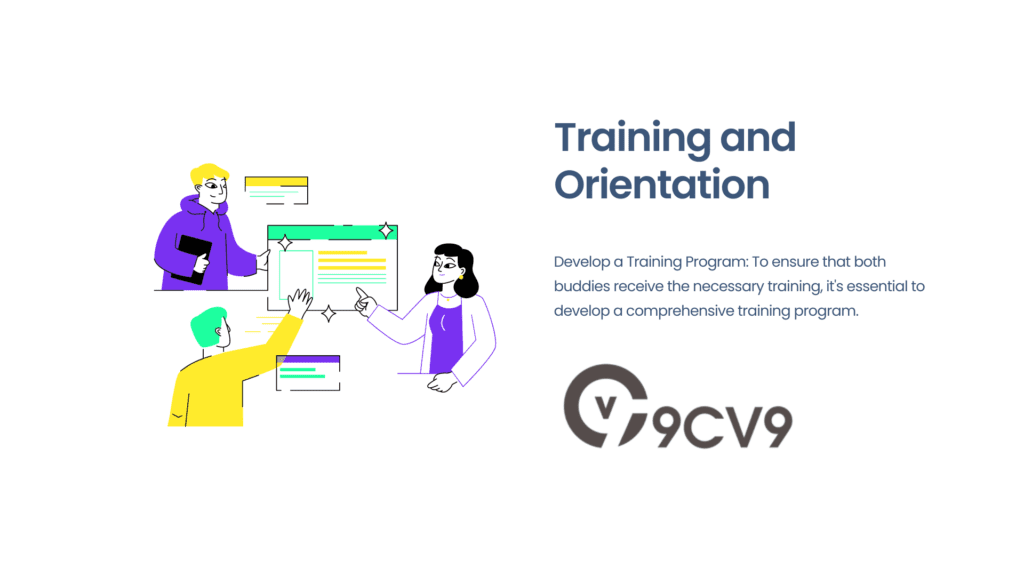
Once you’ve found your match, it’s time for training and orientation.
Yes, you read that right. You may be thinking, “But we’re just buddies, why do we need training?”
Well, my friend, this is not your average friendship.
You’ll want to establish guidelines for communication, confidentiality, and how to handle conflicts.
You’ll also want to set goals and expectations for what you hope to achieve with the buddy system.
Training and orientation are critical components of implementing a successful buddy system in the workplace.
The following are some tips for ensuring that both buddies receive the necessary training and orientation to make the most of their partnership.
Tip #1: Develop a Training Program: To ensure that both buddies receive the necessary training, it’s essential to develop a comprehensive training program. The training program should cover the goals and objectives of the buddy system, the roles and responsibilities of buddies, and best practices for communication and collaboration. Additionally, the training program should include any specific skills or knowledge that buddies need to possess to fulfill their roles effectively.
Tip #2: Provide Orientation: Orientation is a crucial part of the onboarding process, and buddies should receive the same level of orientation as new hires. This includes a thorough introduction to the company culture, policies and procedures, and expectations for job performance. Additionally, buddies should receive a tour of the workplace, an introduction to key personnel, and access to relevant tools and resources.
Tip #3: Facilitate Communication: Effective communication is key to the success of the buddy system. Buddies should be encouraged to communicate regularly and openly to ensure that they are on the same page and working towards the same goals. Additionally, managers should be available to provide support and guidance as needed and facilitate communication between buddies.
Tip #4: Provide Ongoing Support: Training and orientation are just the beginning of the buddy system. Buddies will need ongoing support to ensure that they stay engaged and motivated. This includes regular check-ins to provide feedback and support, opportunities for skill development and knowledge transfer, and recognition for a job well done.
Tip #5: Monitor and Evaluate: Finally, it’s essential to monitor and evaluate the buddy system regularly to ensure that it is effective and meeting its objectives. This includes tracking progress toward goals, soliciting feedback from participants, and making necessary adjustments to the program to ensure that it continues to meet the needs of the organization.
In summary, training and orientation are critical components of implementing a successful buddy system in the workplace.
By developing a comprehensive training program, providing orientation, facilitating communication, providing ongoing support, and monitoring and evaluating the program, you can ensure that your buddy system is effective and provides maximum benefit to all involved.
Remember, this is a professional relationship, not a casual coffee date.
D) Buddy System Guidelines
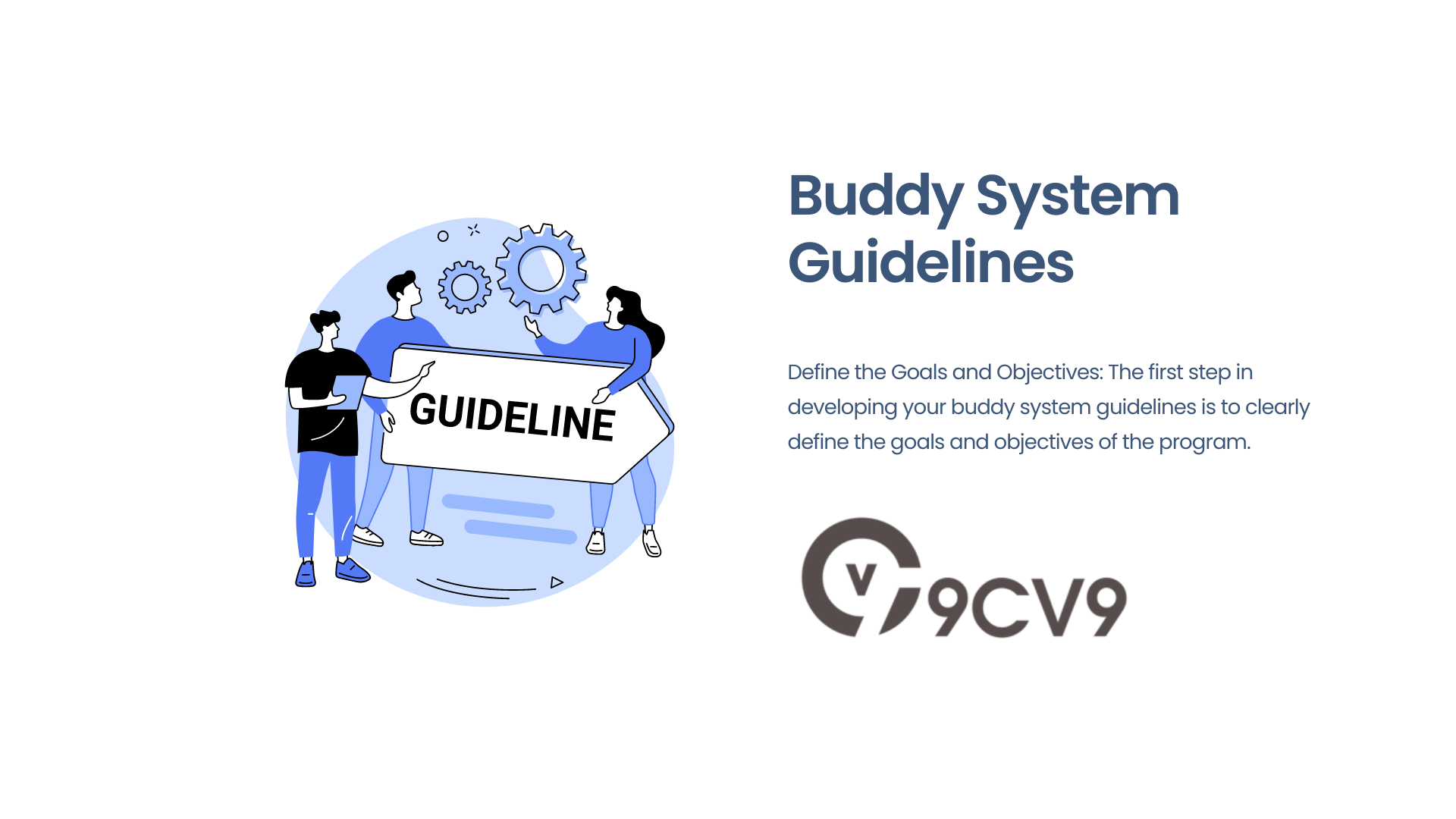
Now that you’re both trained and ready to go, it’s time to establish some buddy system guidelines.
This could include regular check-ins, collaborative projects, and feedback sessions.
You’ll also want to make sure you’re respecting each other’s time and workload.
No one likes to be bombarded with endless emails or meetings that go on for hours.
Implementing a buddy system in the workplace can provide numerous benefits, such as increased job satisfaction, higher productivity, and improved employee retention.
However, to achieve these benefits, it’s important to establish clear guidelines for the buddy system.
The following are some best practices to consider when developing your buddy system guidelines:
- Define the Goals and Objectives: The first step in developing your buddy system guidelines is to clearly define the goals and objectives of the program. What do you hope to achieve with the buddy system, and how will you measure success? By defining these goals, you can ensure that everyone involved in the program is working towards a common objective.
- Establish Roles and Responsibilities: Once you have defined the goals and objectives, it’s essential to establish clear roles and responsibilities for both the buddy and the new employee. Buddies should be responsible for providing guidance and support to the new employee, while the new employee should be responsible for actively seeking feedback and guidance from their buddy.
- Encourage Communication: Effective communication is key to the success of the buddy system. Encourage buddies and new employees to communicate regularly and openly, both formally and informally. This includes regular check-ins, feedback sessions, and opportunities for informal conversation and relationship building.
- Provide Training and Support: Buddies should be equipped with the necessary skills and knowledge to fulfill their roles effectively. This includes training in communication, coaching, and conflict resolution, as well as ongoing support from managers and HR professionals.
- Evaluate and Adjust: Finally, it’s important to evaluate the effectiveness of your buddy system on a regular basis and make necessary adjustments. Solicit feedback from participants and managers to identify areas of improvement, and make changes to the program as needed to ensure that it continues to meet the needs of the organization.
By establishing clear guidelines for your buddy system, you can ensure that the program is effective and provides maximum benefit to all involved.
Remember to define goals and objectives, establish clear roles and responsibilities, encourage communication, provide training and support, and evaluate and adjust the program regularly.
By following these best practices, you can create a successful and sustainable buddy system that helps new employees feel welcome and supported in the workplace.
Keep it focused and productive, and your buddy system will be a well-oiled machine.
And there you have it, folks.
Creating a buddy system in the workplace is not rocket science, but it does require some planning and effort.
Just like any successful relationship, it takes communication, respect, and a little bit of humor.
After all, who wouldn’t want to work with a buddy who can make them laugh during a stressful day?
So, go forth and create your buddy system, and let the good times (and productivity) roll.
2. Best Practices for Successful Buddy System Implementation
Congratulations.
You’ve successfully created a buddy system in the workplace.
Now comes the hard part: actually making it work.
I’m here to give you some best practices to ensure your buddy system is a smashing success.
First and foremost, communication is key.
You’ll want to establish regular check-ins with your buddy to make sure you’re both on the same page and to address any concerns or issues that may arise.
But don’t just limit your communication to work-related topics.
Get to know your buddy on a personal level too.
Talk about your hobbies, interests, and weekend plans.
This will help you build a stronger relationship and make the workplace a more enjoyable place to be.
Another best practice is to set clear goals and expectations for the buddy system.
What do you hope to achieve with this partnership?
Are you looking to improve communication between departments?
Do you want to enhance productivity on a specific project?
Make sure you’re both on board with the goals and that they’re achievable.
When it comes to giving feedback, honesty is the best policy.
But that doesn’t mean you have to be harsh or critical.
Offer constructive criticism in a respectful and supportive manner.
Remember, you’re both working towards the same goal.
If there’s an issue that needs to be addressed, do it in a way that is productive and solution-focused.
Confidentiality is also important in the buddy system.
You’ll want to establish clear guidelines for what can and cannot be shared between buddies.
This could include sensitive information about clients or projects, or even personal details that were shared in confidence.
Trust is a crucial component of any successful relationship, so make sure you’re respecting each other’s privacy.
Finally, don’t be afraid to mix it up.
Just because you’ve found a great buddy doesn’t mean you have to stick with them forever.
It’s okay to switch buddies if your goals or priorities change, or if the partnership isn’t working out as well as you hoped.
Just make sure you’re communicating your needs and concerns with your current buddy before making any changes.
So there you have it, folks.
Best practices for successful buddy system implementation.
Remember to communicate, set clear goals, offer honest feedback, maintain confidentiality, and don’t be afraid to mix it up.
With these tips, your buddy system is sure to be a hit.
Happy budding.
3. Challenges and Solutions
Ah, the buddy system. It sounds so simple in theory, but like most things in life, it’s not without its challenges.
Let’s take a look at some common obstacles you may face when implementing a buddy system in the workplace, and how to overcome them.
Challenge #1: Finding the Right Match As we discussed earlier, finding the right buddy is crucial for the success of the system. But what happens if you can’t find the perfect match? Maybe there are limited options, or perhaps there are personality conflicts. Fear not, my friend. One solution is to consider a group buddy system. Instead of just one-on-one partnerships, create a small group of buddies with similar goals and interests. This way, you’re not relying on just one person to meet all your needs.
Challenge #2: Time Constraints Let’s face it, we’re all busy. Finding time to meet with your buddy can be a challenge, especially if you have conflicting schedules or deadlines. One solution is to schedule regular check-ins at a set time each week, and stick to it. Treat it like any other meeting or deadline. If you can’t meet in person, utilize technology like video calls or instant messaging to stay connected.
Challenge #3: Lack of Commitment Sometimes, despite your best efforts, your buddy may not be as committed to the system as you are. Maybe they’re not showing up to meetings or not following through on their commitments. In this case, it’s important to have an honest conversation with them about your concerns. Try to understand their perspective and see if there’s a way to re-energize the partnership. If not, it may be time to part ways and find a new buddy.
Challenge #4: Burnout Like any relationship, the buddy system can become stale over time. You may feel like you’re stuck in a rut or not making any progress towards your goals. One solution is to switch things up. Try a new activity or project together, or attend a networking event or training seminar. This can help reinvigorate the partnership and keep things fresh.
Challenge #5: Conflict Resolution No matter how well you get along with your buddy, conflicts are bound to arise. Maybe you have different working styles or priorities. The key is to address conflicts head-on and in a respectful manner. Listen to each other’s perspectives and try to find a compromise that works for both of you. If you’re really struggling to find a solution, consider bringing in a mediator or third-party to help facilitate the conversation.
Challenges and solutions for the buddy system in the workplace.
Remember, challenges are inevitable, but with the right mindset and approach, they can be overcome.
Stay committed, communicate openly, and don’t be afraid to switch things up if needed.
Conclusion
We’ve covered everything from the benefits of having a buddy to the challenges you may face and how to overcome them.
Remember, the buddy system is not just a feel-good, touchy-feely concept.
It’s a proven strategy for improving workplace productivity, engagement, and overall job satisfaction.
By pairing up with a buddy, you’re setting yourself up for success and growth.
So, what are you waiting for?
Get out there and start buddy-ing up.
But remember, finding the right buddy takes time and effort.
Don’t rush the process and don’t settle for a less-than-perfect match.
The buddy system is all about mutual support and growth, so choose wisely.
And don’t forget, the buddy system can be fun too.
Use this opportunity to build new relationships and explore new hobbies or interests.
Who knows, you might just find your new best friend or discover a hidden talent.
In conclusion, the buddy system is a powerful tool for improving workplace morale, productivity, and overall success.
So, embrace it, nurture it, and watch your career soar.
Happy buddy-ing, my friends
If you find this article useful, why not share it among your business manager and HR director counterparts, and also leave a nice comment below?
We at the 9cv9 Research Team strive to bring the latest and most meaningful data, guide, and statistics to your doorstep.
Also read some of our awesome articles:
Quiet Promotions: What it is and How to Overcome it?
The Pros of Virtual Internships: What You Need to Know (Updated in 2023)




























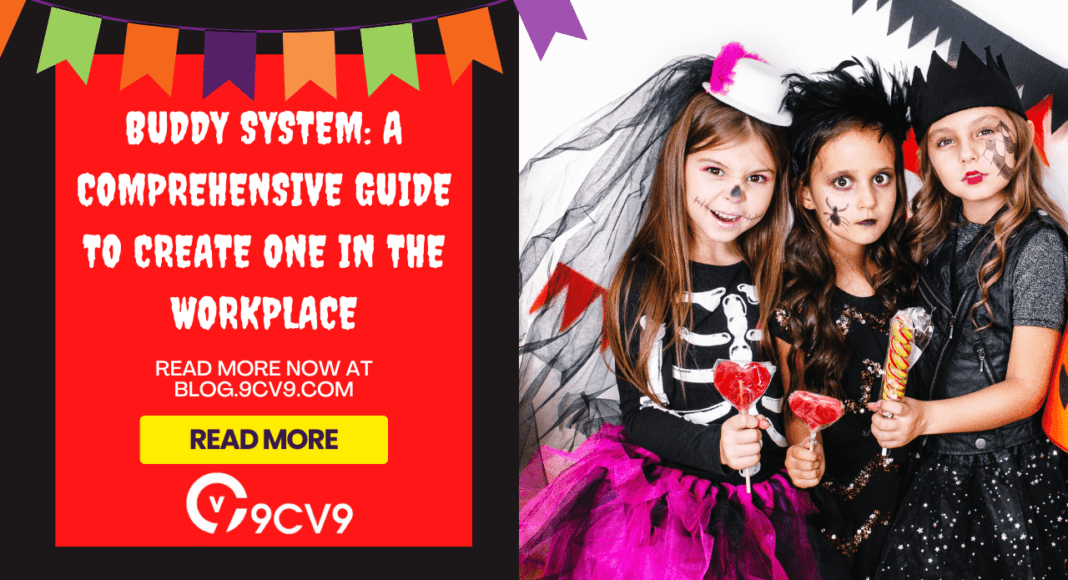


![Writing A Good CV [6 Tips To Improve Your CV] 6 Tips To Improve Your CV](https://blog.9cv9.com/wp-content/uploads/2020/06/2020-06-02-2-100x70.png)


